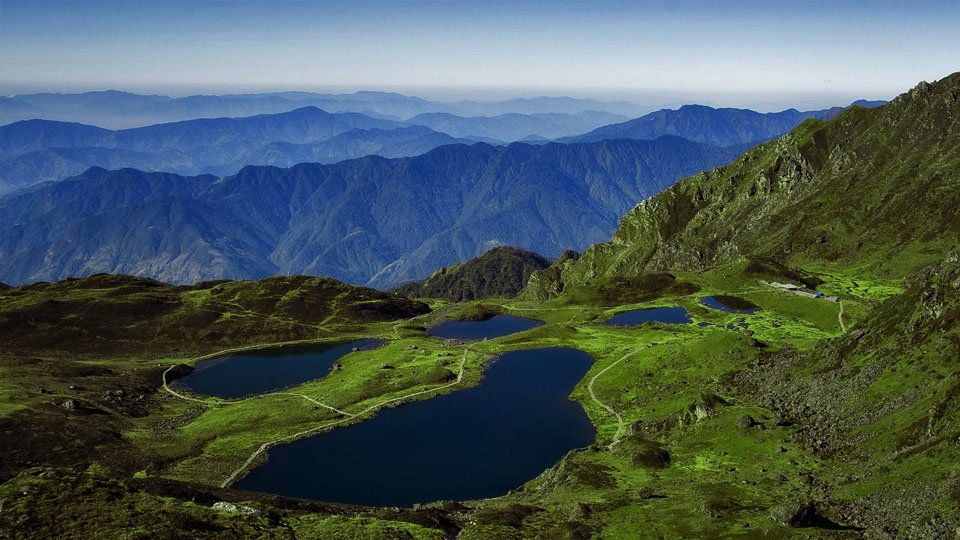Panch Pokhari

Panch Pokhari, meaning "Five Lakes" in Nepali, is a sacred and picturesque site located in the Langtang region of Nepal. Situated at an altitude of approximately 4,100 meters (13,451 feet), Panch Pokhari is a cluster of five alpine lakes, each possessing its own unique beauty and charm.
Considered holy by both Hindus and Buddhists, Panch Pokhari is a significant pilgrimage site, especially during the Janai Purnima festival in August. Many devotees visit the lakes to pay their respects and seek blessings.
The crystal-clear waters of the lakes reflect the surrounding snow-capped peaks, creating a serene and breathtaking atmosphere. The panoramic views from Panch Pokhari include the towering Langtang Lirung, Dorje Lakpa, Jugal Himal, and Rolwaling Himal ranges, adding to the beauty and grandeur of the place.
Among Nepal's off-the-beaten-path trekking adventures, Panch Pokhari Trek is an exciting one. Panch Pokhari, which translates to "Five Lakes" in Nepali and refers to a collection of holy alpine lakes situated at an elevation of about 4,100 meters (13,451 feet), is a region in Langtang.
The trek begins with a scenic drive from Kathmandu to Chautara, the starting point of the trek. From there, you will embark on a journey through diverse landscapes, including lush forests, terraced fields, and picturesque villages.
One of the highlights of the Panch Pokhari Trek is the opportunity to visit the five pristine lakes after which the trek is named. These lakes are considered holy by both Hindus and Buddhists and are a significant pilgrimage site during the Janai Purnima festival in August. The crystal-clear waters of the lakes surrounded by snow-capped peaks create a serene and awe-inspiring atmosphere.
The trek offers breathtaking panoramic views of the Himalayan ranges, including Langtang Lirung, Dorje Lakpa, Jugal Himal, and Rolwaling Himal. The route takes you through remote and less-frequented trails, providing a sense of solitude and tranquility amidst nature.
Along the way, you will encounter the unique culture and hospitality of the local Tamang and Sherpa communities. You can witness their traditional lifestyle, visit ancient monasteries, and learn about their customs and traditions.
The Panch Pokhari Trek is considered a moderate trek that requires a reasonable level of fitness and endurance. The trek can be completed in around 10 to 12 days, depending on the specific itinerary and pace.
With its pristine lakes, breathtaking mountain vistas, cultural encounters, and peaceful surroundings, the Panch Pokhari Trek offers a remarkable and authentic trekking experience in the lesser-explored Langtang region of Nepal. It is a perfect choice for trekkers seeking a unique and off-the-beaten-path adventure in the Himalayas.
Day 1: Arrival in Kathmandu
Arrive in Kathmandu and transfer to your hotel. Spend the day exploring the vibrant streets of Kathmandu and preparing for the trek.
Day 2: Kathmandu to Chautara (1,450 meters)
Drive from Kathmandu to Chautara, the starting point of the trek. The drive takes approximately 4-5 hours. Overnight stay in Chautara.
Day 3: Chautara to Sano Okhareni (2,020 meters)
Begin trekking from Chautara and ascend through terraced fields and forests. Reach Sano Okhareni and camp for the night.
Day 4: Sano Okhareni to Kami Kharka (2,830 meters)
Trek through rhododendron and pine forests, passing small villages and panoramic viewpoints. Reach Kami Kharka and set up camp for the night.
Day 5: Kami Kharka to Pauwa Bas (3,000 meters)
Continue trekking uphill, enjoying the views of the Himalayan ranges. Reach Pauwa Bas and camp for the night.
Day 6: Pauwa Bas to Hille Bhanjyang (3,400 meters)
Trek through a rugged trail, crossing streams and passing through yak pastures. Ascend to Hille Bhanjyang and camp for the night.
Day 7: Hille Bhanjyang to Nasim Pati (3,700 meters)
Ascend further through rocky terrain and alpine landscapes. Reach Nasim Pati, a beautiful camping site, and spend the night there.
Day 8: Nasim Pati to Panch Pokhari (4,100 meters)
Today, you will reach the destination of the trek - Panch Pokhari. Trek through high ridges, enjoying panoramic mountain views. Upon reaching Panch Pokhari, take in the serene beauty of the five sacred lakes. Camp near the lakes.
Day 9: Explore Panch Pokhari
Spend a rest day at Panch Pokhari to explore the lakes and surrounding areas. Take in the spiritual and natural ambiance, and enjoy the breathtaking views.
Day 10: Panch Pokhari to Tupi Danda (2,320 meters)
Begin descending from Panch Pokhari, retracing your steps through alpine landscapes. Reach Tupi Danda and camp for the night.
Day 11: Tupi Danda to Dhap (1,200 meters) and return to Kathmandu
Descend through forests and terraced fields, passing small villages. Reach Dhap and drive back to Kathmandu. Overnight stay in Kathmandu.
Day 12: Departure from Kathmandu
Depart from Kathmandu with cherished memories of the Panch Pokhari Trek.
- Airport transfers: Pick-up and drop-off at the airport in Kathmandu.
- Accommodation: Hotel accommodation in Kathmandu and teahouse/guesthouse accommodation during the trek.
- Meals: Breakfast, lunch, and dinner during the trek (typically vegetarian options).
- Experienced guide and porters: A licensed and experienced trekking guide who will accompany you throughout the trek. Porters to carry the necessary equipment and your personal belongings.
- Permits and fees: Trekking permits (such as the Langtang National Park entry permit) and necessary government fees.
- Transport: Transportation from Kathmandu to Chautara (the starting point of the trek) and back to Kathmandu.
- Trekking equipment: Tents, sleeping bags, and other necessary camping equipment during the trek.
- Medical kit: Basic first aid kit and emergency medical supplies.
- Welcome and farewell dinner: A cultural dinner in Kathmandu to welcome you and celebrate the completion of the trek.
- International flights: Flights to and from Nepal are typically not included.
- Travel insurance: It is highly recommended to have travel insurance that covers trekking activities and emergencies.
- Nepal visa: The cost of obtaining a visa to enter Nepal.
- Personal expenses: Expenses for beverages, snacks, additional meals, internet, hot showers, and other personal items.
- Extra services: Any additional services or activities not mentioned in the itinerary, such as sightseeing tours in Kathmandu.
- Tips: Tips for the trekking staff (guide, porters) as a gesture of appreciation for their services.
- Extra accommodation: Accommodation in Kathmandu before or after the trek.
- Evacuation expenses: In the event of a medical emergency or helicopter rescue, the cost of evacuation or medical treatment is typically not included.
How difficult is the Panch Pokhari Trek?
The Panch Pokhari Trek is considered a moderate to challenging trek. It involves trekking through varied terrains, including steep ascents and descents, rocky paths, and rugged landscapes. A reasonable level of fitness and prior trekking experience is recommended to complete the trek comfortably.
What is the best time to do the Panch Pokhari Trek?
The best time to do the Panch Pokhari Trek is during the spring (March to May) and autumn (September to November) seasons. These months offer stable weather, clear skies, and moderate temperatures, providing favorable conditions for trekking and enjoying the stunning views.
Are permits required for the Panch Pokhari Trek?
Yes, you will need permits to trek in the Panch Pokhari region. The required permits include the Langtang National Park entry permit and the TIMS (Trekkers' Information Management System) card. These permits can be obtained in Kathmandu or at the entry checkpoint of the Langtang National Park.
Is altitude sickness a concern during the trek?
Altitude sickness can be a concern during the Panch Pokhari Trek, as the maximum altitude reaches approximately 4,100 meters (13,451 feet). It is crucial to acclimatize properly, drink plenty of fluids, and listen to your body. Having rest days and following a gradual ascent is essential to minimize the risk of altitude-related illnesses.
Are there teahouses or lodges along the Panch Pokhari Trek route?
Yes, there are teahouses or lodges available along the Panch Pokhari Trek route. However, the number of teahouses may be limited compared to more popular trekking routes. The teahouses provide basic accommodation and meals, but the facilities may vary. It is advisable to be prepared for simpler accommodations and carry necessary items such as a sleeping bag.
Can I hire a guide or a porter for the trek?
Yes, hiring a guide or a porter for the Panch Pokhari Trek is possible and recommended. A knowledgeable guide can assist with navigation, provide information about the region, and ensure your safety. A porter can carry your heavy backpack, allowing you to trek with less weight on your shoulders.
What should I pack for the Panch Pokhari Trek?
Some essential items to pack for the Panch Pokhari Trek include sturdy trekking boots, comfortable clothing, warm layers, a waterproof jacket, a hat, gloves, a good-quality sleeping bag, a water bottle, a sun hat, sunglasses, sunscreen, a first aid kit, and personal toiletries. It is important to pack light and carry only the necessary items.
Is it possible to combine the Panch Pokhari Trek with other treks in the Langtang region?
Yes, it is possible to combine the Panch Pokhari Trek with other treks in the Langtang region. Some popular options include the Langtang Valley Trek, Gosainkunda Trek, or even extending the trek to Helambu. These combinations offer a more extensive trekking experience and a chance to explore different landscapes and cultural aspects of the region.




